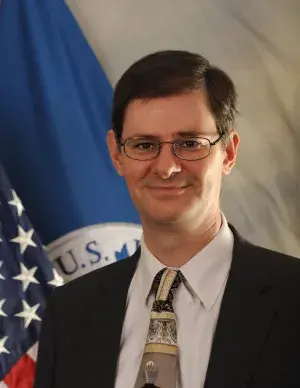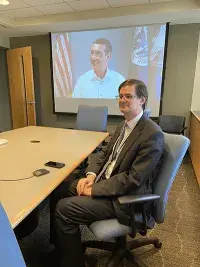
Editor’s Note: As TSA’s Chief Medical Officer, Dr. Fabrice Czarnecki helps ensure the TSA workforce is mission ready. He manages health policy, maintains medical records and serves as TSA’s physician authority for medical determinations. In this Q&A, he reflects on TSA’s mission, current events and how the pandemic has affected him.
What part of the TSA mission do you feel most passionate about?
The overall mission of protecting the security of the traveling public is important and personal, as I enjoy traveling with my family. Making sure TSA employees who ensure my family’s safe travel are not impaired for medical reasons is good motivation for doing my job.
I am passionate about each employee’s health and well-being, as I am when treating patients. TSA’s mission is secured in the abilities of individual Transportation Security Officers (TSOs) to perform their duties, that collectively with their coworkers, delivers the mission. Furthermore, their work is physically and mentally demanding.
When TSA screening officers come to work, they must be capable of performing 89 essential job functions to be considered fit for duty. As an occupational medicine physician, I have the responsibility of determining the correlation between the ability to perform all 89 job functions and the possible impairments caused by specific illnesses or injuries. Using my skills in occupational medicine, I write TSA’s medical guidelines to meet the specific job functions of each covered position.
As an emergency physician, I can identify with the impact of a chronic illness on an employee’s life. As TSA’s chief medical officer, I safeguard TSA’s mission by determining if an employee is fit to conduct every essential job function.
What particular skill or talent of yours do you feel the COVID-19 crisis has allowed you to tap into? How have you been able to use that skill or talent for the good of TSA?
My second mission, protecting the safety of TSA employees, has become my primary role since I began tracking COVID-19 in late December 2019. I have applied my skills in epidemiology to track the evaluation of the outbreak and the transmission of the virus to determine real-time risk factors for TSA employees and passengers.
I use this information stream to make recommendations for evidence-based changes in protective equipment and procedures to prevent transmission to passengers and employees. I currently assist in making changes to the checkpoint design and processes from industrial hygiene, ergonomics and epidemiological perspectives.
Medical professionals from all forms of practice have had to pull together in response to the unfamiliar. Protecting TSA employees is inherently personal in my professional response. As both a father and an emergency physician treating patients with highly contagious illnesses, I have experienced the same extraordinary worry COVID-19 has caused for our employees.
Have you had any time for relaxation during this unprecedented time? If so, what did you do?
The enormity of the COVID-19 response commands a 24/7 response. My workdays routinely last 10-12 hours. To help me relax I take daily walks with my daughter and our dog.
What do you look forward to doing again when social distancing is finally lifted?
Like many of us, we have postponed our vacation to Disney World. I’m looking forward to passing through Ronald Reagan Washington National Airport (DCA) checkpoint with my family to catch a flight to Orlando.
I’m also looking forward to attending rescheduled medical conferences. These conferences are great resources of information and practices on issues ranging from COVID-19 to new medical treatments that could require changes in TSA medical guidelines.
Is there anything you’d like to say to your colleagues at this stage of the pandemic?
Be assured, my continued priority is protecting TSA’s employees as business returns to normal. The agency’s response will involve a combination of increased personal protections, modifications of procedures for both employees and passengers and adaptation of our technologies.
Individually, we cannot drop our guard as we await a vaccine. We should anticipate spikes in the number of reported transmissions of the virus. We have all learned how to protect ourselves and, with the added levels of protection and changes in procedures, we should be safer in performing our jobs. We should continue to remain vigilant as passenger volume increases.


